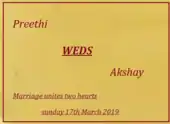Hindu wedding cards
Hindu wedding cards and invitations have a significant role in Hindu marriage, helping symbolizing eternal affection and bonding. These invitations are intricately designed on handmade paper with vibrant colors in order to better express the emotions felt by the bride and groom. They embody the joy, liveliness, and celebration of the Hindu matrimonial ceremony. Hindu invitations often feature religious symbols like Lord Ganesha and Mangal Ghat in order to seek divine blessings. Over time, the significance of these Hindu cards and invitations has evolved with the widespread growth of Hindu culture. Additionally, it is customary to present the wedding cards to the eldest members of the family first, seeking their blessings. Hindu wedding cards serve as a means to invite and honor the presence of loved ones in the family.
Invitation Features
Invitation wordings
Invitation wording encompasses a collection of wedding invitation verses, wordings, and text templates for various special ceremonies. By examining the content of the wedding invitation, one can gain a comprehensive understanding of the wedding type, such as whether it is a Hindu or Christian celebration. In the context of Hindu invitations, the inclusion of appropriate wording is essential. These wordings hold great significance in creating the perfect card. The invitation wordings in Hindu wedding cards maintain a formal tone and are used for various ceremonies, including mehandi, engagement, wedding sangeet, wedding ceremony, and reception invitation wordings.
Printable symbols
A wide range of printable symbols, including Lord Ganesha, Om, and Mangal Ghat, can be found on Hindu wedding invitation cards. These symbols hold religious significance and are sometimes chosen by the bride and groom to align with the theme of the wedding. Hindu cards feature a variety of classic and artistic symbols, each meticulously designed to enhance the visual appeal of the invitation. The inclusion of printable symbols adds elegance and a fresh, refined appearance to the Hindu wedding invitation cards. These symbols enjoy widespread popularity and are gaining recognition worldwide.
Printing techniques

Advancements in technology have revolutionized the printing methods used for wedding invitation cards. Just as the invitation wording and design reflect the style of the wedding, the chosen printing technique communicates the level of formality of the entire ceremony. The selection of a printing method also has a significant impact on the wedding budget and helps determine the appropriate design and paper type. With the availability of high-quality printing techniques, Hindu invitations can be printed using various methods such as flocking, embossing, hot foil stamping, laser cutting, raised silk screen printing, offset printing, letterpress, thermography, engraving, and more, adding a multidimensional look to the invitation cards. The choice of printing technique depends on the desired aesthetic and the allocated budget.
Theme-based cards
Hindu wedding cards are often tailored to match the chosen wedding theme. As couples increasingly seek unique and personalized wedding celebrations, theme-based weddings have gained significant popularity worldwide. These weddings serve as a platform to showcase the distinctive nature of the matrimonial event. Examples of theme-based weddings include Hollywood glamour themes, medieval themes, Harry Potter themes, and ethnic theme-based weddings.
Types of paper
Various types of paper are now used for printing Hindu wedding invitation cards, reflecting both technological advancements and the desire for elegant weddings. These paper types include shimmery metallic paper, matte-finish boards, fabric paper, handmade metallic paper, handmade silk paper, handmade cotton paper, velvet paper, and vellum paper.
Add-on cards
In response to changing trends, there has been an increased demand for add-on cards to accompany the main Hindu wedding invitation cards. These add-on cards serve as complementary elements and include options such as RSVP cards, thank-you cards, program booklets, menu cards, and place cards.